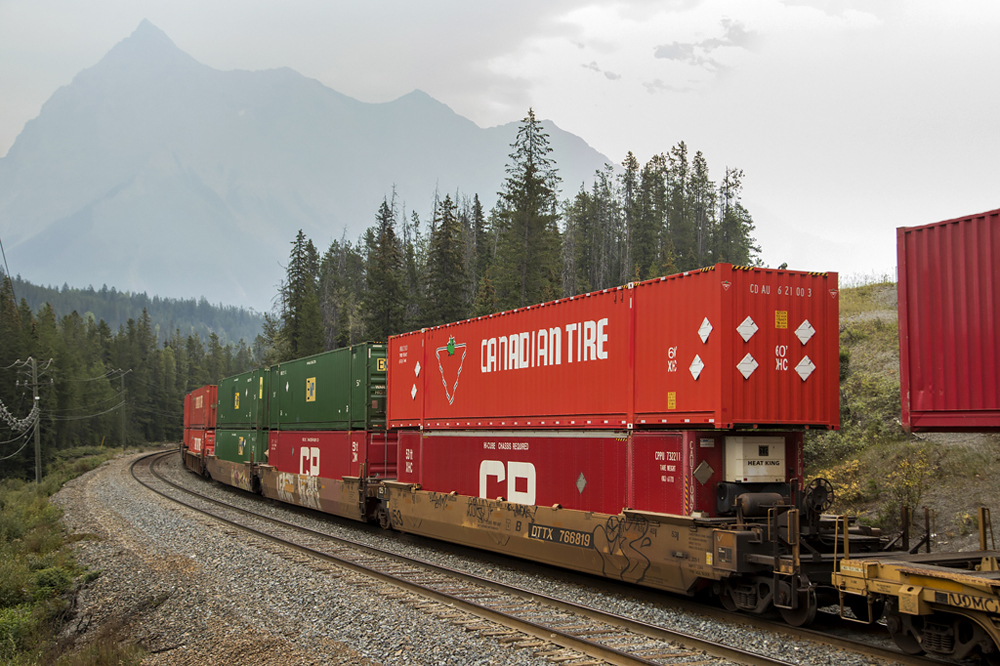
CHICAGO — It’s been five years since Canadian Pacific and retail giant Canadian Tire Corp. unveiled North America’s first 60-foot intermodal container, and intermodal analyst Larry Gross says the larger container type is probably going to remain exclusive to Canada for the foreseeable future.
CP and Canadian Tire launched service with the larger container in May 2017 [see “Canadian Pacific, Canadian retail company unveil …,” Trains News Wire, May 1, 2017].
U.S. federal regulations limit trailers to 53 feet and while states can request oversize units, Gross says the load typically needs to be indivisible, which is not the case with a 60-foot container. In comparison, provincial governments in Canada allow longer truck lengths, which accomodates the 60-foot container as long as they are hauled by short-wheel-base tractors in order to comply with overall total truck length.
In Canada, some provinces allow total truck and trailer lengths of 75 feet, while the U.S. standard is closer to 72 feet.
“Beyond that, the highway weight laws are more generous in Canada than in the U.S.,” he says, allowing Canadian Tire to take advantage of the 13% additional cube offered by the 60-foot compared to the U.S.-standard 53-foot container.
In the U.S., the maximum truck weight on highways is 80,000 pounds gross weight, while certain provinces in Canada allow up to 120,000 pounds. Gross says in the U.S., the extra weight of the longer box and chassis would come directly out of the 80,000-pounds, thereby limiting payload capacity.
“Lastly, if you’ve ever watched a 53-foot rig negotiate a corner, you will be familiar with ‘off-tracking’ which is simply the amount of encroachment on the inside of the turn on the part of the trailer tandem,” he says. “You’ll see situations whereas the truck tries to make a right turn, the back end of the trailer starts coming close to or onto the sidewalk. In the case of a left turn, the issue is conflict with waiting cars on the cross street who are watching the rear end of the trailer get uncomfortably close to their front bumper. The greater the distance between the trailer kingpin and the centerline of the tandem, the worse this issue becomes.
“Bottom line is I don’t see 60-foot boxes in [the United States’] future.”
Canadian Tires’ 60-foot container is the result of a close partnership between Canadian Pacific and the retail company, debuted in 2017, for use on Canadian Pacific’s coast-to-coast intermodal network in Canada. Canadian Tire has more than 500 retail locations and more than 22 million square feet of rail space across Canada.














We use 45 foot in the uk but have now got 53 foot trailers with a rear steer axle. They are all tri axle trailers and take some getting used to but take corners and roundabouts better due to the rear steering axle linked to a box on the trailer in the turntable jaws . All gross out at 44,000 kilos but there are plans for 50,000 kilos and all on air suspension . Perhaps a LST or long steer trailer might be better
When 48 footers first arrived on the scene they were restricted to terminal to terminal only. That didn’t last long. Now I see P & D drivers making local deliveries with the 53’s.
These containers probably do not haul many tires. Canadian Tire is a department store with a lot of different goods being sold, so the containers probably have tools, sporting goods, home decor, and other such items packed into them.
Canadian Tire is just one of the stores owned by Canadian Tire Corporation, Limited, and most likely those 60′ containers were specifically built to haul tires only. The other commodities you mentioned are most likely not sold in Canadian Tire stores, but other stores owned by Canadian Tire Corp.(i.e. Mark’s, FGL Sports, PartSource, and the Canadian operations of Party City).
Tim is correct Gerald, Canadian Tire Stores sell many many consumer goods, they are a main competitor of Walmart in this area of retail. If anything few tires are probably in these 60’s. My local CT is probably 300000 square feet and might have 20 tires on display in a corner.
Have a look at a Canadian Tire on line weekly flyer if you would like to get an idea of their store inventory.
Who, but Canadian Tire benefit from 60′ containers? After all, 80% of the volume of a tire is air, so they cube out before they tare out. Are UPS or FedEx small package services participating or looking at these? If they do, could that be the way they migrate into the US?
Canadian Tire is “more than just tires”, as their old jingle says. They’re also a big housewares, hardware, and sporting goods retailer.
While pulling 48’s in the early 90’s I thought 53-footers was nuts. Traveling the nation’s highways was never an issue. Once you got into towns for pickup/deliveries the fun began. So happy this country still has those willing to live that lifestyle and to deliver the last mile. Personally, I don’t miss it.